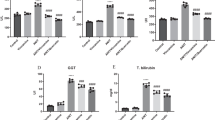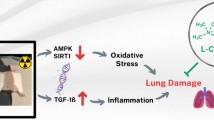Abstract
The genotoxic effect of chloroquine (CQ), a 4-aminoquinoline antimalarial drug was investigated in rat liver cells using the alkaline comet assay. Chloroquine (0–1000 μmol/L) significantly increased DNA strand breaks of rat liver cells dose-dependently. Rat liver cells exposed to CQ (100–500 μmol/L) and treated with endonuclease III and formamidopyrimidine-DNA glycosylase, the bacterial DNA repair enzymes that recognize oxidized pyrimidine and purine, respectively, showed greater DNA damage than those not treated with the enzymes, providing evidence that CQ induced oxidation of purines and pyrimidines. Treatment of cells with 5 mmol/L N-acetylcysteine, an intracellular reactive oxygen species (ROS) scavenger, and 100 μmol/L and 250 μmol/L deferoxamine, an established iron chelator, significantly decreased the CQ-induced strand breaks and base oxidation, respectively. Similarly, the formation of DNA strand breaks and oxidized bases was prevented by vitamin C (10 μmol/L) (a water-soluble antioxidant), quercetin (50 μmol/L) (an antioxidant flavonoid), and kolaviron (30 μmol/L and 90 μmol/L) (an antioxidant and a liver hepatoprotective phytochemical). The results indicate that the genotoxicity of CQ in rat liver cells might involve ROS and that free radical scavengers may elicit protective effects in these cells.
Similar content being viewed by others
Abbreviations
- CQ:
-
chloroquine
- DFO:
-
deferoxamine
- DMSO:
-
dimethyl sulfoxide
- Endo III:
-
endonuclease III
- FCS:
-
fetal calf serum
- FPG:
-
formamidopyrimidine glycosylase
- MES:
-
4-morpholinoethane sulfonic acid
- NAC:
-
N-acetylcysteine
- ROS:
-
reactive oxygen species
- SDS:
-
sodium dodecyl sulfate
References
Anderson D, Yu TW, Phillips BJ, Schmezer P. The effect of various antioxidants and other modifying agents on oxygen-radical-generated DNA damage in human lymphocytes in the COMET assay. Mutat Res. 1994;307:261–71.
Aruoma OI, Halliwell B, Hoey BM, Butler J. The antioxidant action of N-acetylcysteine: its reaction with hydrogen peroxide, hydroxyl radical, superoxide, and hypochlorous acid. Free Rad Biol Med. 1989;6:593–97.
Blasiak J, Arabsk M, Pertynski T, Malecka-Panas E, Wozniak K, Drzewoski J. DNA damage in human colonic mucosa cells evoked by nickel and protective action of quercetin–involvements of free radicals? Cell Biol Toxicol. 2002;18:279–88.
Blasiak J, Sikora A, Wozniak K, Drzewoski J. Genotoxicity of streptozotocin in normal and cancer cells and its modulation by free radical scavengers. Cell Biol Toxicol. 2004;20:83–96.
Breman JG, Egan A, Keusch GT. The intolerable burden of malaria: a new look at the numbers. Am J Trop Med Hyg. 2001;64:11.
Chatterjee T, Muhkopadhyay A, Khan KA, Giri AK. Comparative mutagenic and genotoxic effects of three antimalarial drugs, chloroquine, primaquine and amodiaquine. Mutagenesis. 1998;13:619–24.
Chen TH, Chang PC, Chang MC, Lin YF, Lee HM. Chloroquine induces the expression of inducible nitric oxide synthase in C6 glioma cells. Pharmacol Res. 2005;51:329–6.
Collins AR. Oxidative DNA damage, antioxidants and cancer. Bioassays. 1999;21:238–46.
Collins AR, Duthie SJ, Dobson VL. Direct enzymatic detection of endogenous base damage in human lymphocyte DNA. Carcinogenesis. 1993;14:1733–35.
Collins AR, Dobson VL, Dusinska M, Kennedy G, Stetina R. The comet assay: what can it really tell us? Mutat Res. 1997;375:183–93.
De D, Krogstad FM, Cogswell FB, Krogstad DJ. Aminoquinolines that circumvent resistance in Plasmodium falciparum in vitro. Am J Trop Med Hyg. 1996;55:579–83.
Duthie SJ, Collins AR, Duthie GG, Dobson VL. Quercetin and myricetin protect against hydrogen peroxide-induced DNA damage (strand breaks and oxidized pyrimidines) in human lymphocytes. Mutat Res. 1997; 393:223–31.
Emerole GO, Thabrew MI. Changes in some rat hepatic microsomal components induced by prolonged administration of chloroquine. Biochem Pharmacol. 1983;32:3005–9.
Evans MD, Podmore ID, Daly GJ, Pewrrett D, Lunec J, Herbert KE. Detection of purine lesions in cellular DNA using single cell electrophoresis with FPG protein. Biochem Soc Trans. 1995;23:434S.
Farombi EO, Emerole GO. Interference of common antimalarial drugs with some hepatic microsomal components and drug metabolism: potential implications for toxicity. S Afr J Sci. 1998;94:303–4.
Farombi EO, Olowu BI, Emerole GO. Effect of three structurally related antimalarial drugs on liver microsomal components and lipid peroxidation in rats. Comp Biochem Physiol. 2000;126:217–24.
Farombi EO, Adoro S, Uhunmwangho S. Antimalarial drugs exacerbate rat liver microsomal lipid peroxidation in the presence of oxidants. Biosci Rep. 2001;21:353–9.
Farombi EO, Akanni OO, Emerole GO. Antioxidative and scavenging activities of kolaviron in vitro. Pharm Biol. 2002;40:107–16
Farombi EO, Shyntum YY, Emerole GO. Influence of chloroquine treatment and malaria infection on some enzymatic and non-enzymatic antioxidants in humans. Drug Chem Toxicol. 2003;26:59–71.
Farombi EO, Moller P, Dragsted LO. Ex-vivo and in-vitro protective effects of kolaviron against oxygen-derived radical-induced DNA damage and oxidative stress in human lymphocytes and rat liver cells. Cell Biol Toxicol. 2004;20:71–82.
Hartmann A, Speit G. Genotoxic effects of chemicals in the single cell gel (SCG) test with human blood cells in relation to the induction of sister-chromatid exchanges (SCE). Mutat Res. 1995;346: 49–56.
Iwu MM. Antihepatotoxic constituents of Garcina kola seeds. Experientia. 1985;41:699–70.
Magwere T, Naik YS, Hasler J. Effects of chloroquine on antioxidant enzymes in rat liver and kidney. Free Radic Biol Med. 1997;22: 321–27.
Meister A, Anderson ME. Glutathone. Annu Rev Biochem. 1983;52: 711–60.
Middleton E, Kandaswami C, Theoharides TC. The effects of plant flavonoids on mammalian cells: implications for inflammation, heart disease and cancer. Pharmacol Rev. 2000;52:673–751.
Mosuro AAO. Genotoxicity of antimalarial drugs 1: the 4-aminoquinolines. Biokemistri. 1997;7:9–18.
Nakayama T, Yamada M, Osawa T, Kawakishi S. Suppression of active-oxygen-induced cytotoxicity by flavonoids. Biochem Pharmacol. 1993;45:265–7.
Nappi AJ, Vass E. Comparative studies of enhanced iron-mediated production of hydroxyl radical by glutathione, cysteine, ascorbic acid and selected catechols. Biochim Biophys Acta. 1997;1336:295–1.
Obaseki-Ebor EE, Obasi EE. Aspects of chloroquine mutagenicity. Mutat Res. 1986;175:51–9.
Reitz M, Lorei W, Lettko M. DNA single strand breaks in human lymphocytes after therapy with antirheumatic drugs. Arzneimittelforschung/Drug Res. 1991;41(II):1141–4.
Riccio ES, Lee PS, Winegar RA, Krogstad DJ, De D, Mirsalis JC. Genetic toxicology testing of the antimalarial drugs chloroquine and a new analog, AQ-13. Environ Mol Mutagen. 2001;38:69–79.
Schupbach ME. Chemically induced transmissible abnormalities in sperm-head shape. Mutat Res. 1979; 68:41–9.
Summer AP, Stauffer WM, Fischer PR. Pediatric malaria in the developing world. Semin Pediatr Infect Dis. 2005;16:105–15.
Snyder RD, Arnone MR. Putative identification of functional interactions between DNA intercalating agents and topoisomerase II using the V79 in vitro micronucleus assay. Mutat Res. 2002;503:21–35.
Thein N, Moller P, Amtoft H, et al. A strong genotoxic effect in mouse skin of a single painting of coal tar in hairless mice and in MutaTM Mouse. Mutat Res. 2000;468:117–24.
Thomas SM, Silburn KA, MacPhee DG. Frameshift mutagenesis by chloroquine in Escherichia coli and Salmonella typhimurium. Mutat Res. 1987;192:233–7.
Tice RR, Agurell E, Anderson D, et al. Single cell gel/comet assay: guidelines for in vitro and in vivo genetic toxicology testing. Environ Mol Mutagen. 2000;25:206–21.
Toler SM. Oxidative stress plays an important role in the pathogenesis of drug-induced retinopathy. Exp Biol Med. 2004;229:607–15.
Weitberg AB, Weitzman SA. The effect of vitamin C on oxygen radical-induced sister chromatid exchanges. Mutat Res. 1985;144:23–6.
Zegura B, Lah TT, Filipic M. The role of reactive oxygen species in microcystin-LR-induced DNA. Toxicology. 2004;200:59– 68.
Author information
Authors and Affiliations
Corresponding author
Rights and permissions
About this article
Cite this article
Farombi, E.O. Genotoxicity of chloroquine in rat liver cells: Protective role of free radical scavengers. Cell Biol Toxicol 22, 159–167 (2006). https://doi.org/10.1007/s10565-006-0173-2
Received:
Accepted:
Issue Date:
DOI: https://doi.org/10.1007/s10565-006-0173-2




